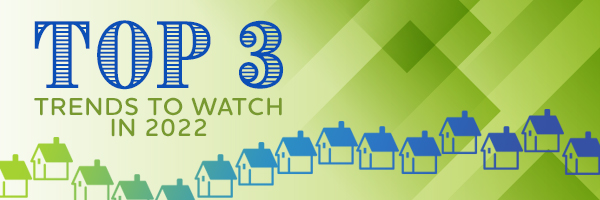Virginia Association of Realtors issued the following announcement on Dec. 10
This year has been a wild ride in Virginia’s housing market. But what does 2022 have in store? Let’s take a quick look ahead on how some of the key trends we’ve been seeing could impact the housing market in 2022.
Home Prices: Are we headed for a crash? Or are prices going to continue to surge? The answer is likely neither.
We predict that home prices will continue to rise in many areas, but at a more modest pace. The frenzied price growth in the housing market over the past year and a half has been unprecedented, fueled by strong demand, low supply, and historically low mortgage rates. So, why do we expect price growth to moderate in the coming year?
First, mortgage interest rates are trending up and are expected to continue rising. This puts downward pressure on home prices because many buyers will be more price-sensitive than they might have been in 2020 and 2021 when rates were often below 3%.
In addition to rising rates, the soaring home prices have led to affordability challenges in many markets around the commonwealth. As bidding wars ease, and homes are on the market for longer, list prices will likely continue to calibrate and become more competitive, which is good news for buyers.
While price growth will slow, we are definitely not seeing any signs of a crash in prices. The fundamentals in the market still remain strong, and there is no shortage of buyer demand. Couple that with persistently low inventory, and there is no red flag that prices are poised to fall like they did in the Great Recession more than a decade ago, when we had an oversupply of homes and very loose mortgage underwriting standards.
Location: City life or rural living? Will Virginia’s urban markets make a comeback in 2022, or will “zoom towns” continue to attract people away from them?
We predict that demand will shift back towards urban/suburban markets near employment centers in many parts the state in the coming year. As we saw over the past year and a half, there was a surge in buyer activity in places outside of Virginia’s urban markets; places referred to “zoom towns.” Many people did not want to live in dense communities as the pandemic took hold on daily life. The idea of having a more space in less-crowded neighborhoods was appealing as lifestyles shifted dramatically; however, a lot has changed since those early lock-down days of the pandemic.
The main drivers of this anticipated shift back toward urban markets are the fact that more offices are planning to go back to in-person/hybrid schedules next year, schools are open for in-person learning across Virginia, and many of the restaurants, entertainment venues, and retail businesses that make urban living vibrant and appealing are reverting to more normal operations.
Of these factors though, a return to office life, even if it is only for a few days a week, is likely the most influential driver in Virginia’s urban and suburban housing markets heading into 2022. While this remains a moving target for most companies and government agencies, many have targeted 2022 for phased re-openings. If this occurs, it will make locations that are commutable to employment centers more desirable than they were in 2020 and 2021. We’ve already started to see these trends in the housing data this fall, and we expect it will continue into the coming year.
While COVID-19 variants like Omicron and others will continue to be a wildcard, the fact that more elements of daily life, such as work, school, dinning, and recreation are starting to resemble more “normal times,” it is likely that housing markets in urban and suburban communities will see more growth in 2022 than they had in the past couple years.
Inventory: Same story different year?
We predict that the supply picture will improve from the very low levels last year, but the inventory shortage will likely linger through 2022 and beyond. A key to the low inventory continues to be that new home construction is facing challenges on multiple fronts (e.g., material price surges, supply-chain issues, regulatory constraints, labor shortages, etc.). Based on these constraints, we are forecasting new home starts to be essentially flat in 2022 compared to last year, which will not have a significant impact on the overall housing supply in the state.
On the existing home side, there have been some early signs that overall supply is improving, albeit slightly. The inventory in Virginia’s housing market is still lower than last year, but the pace of decline has been moderating for the past several months. In some regions in the state, active listings have actually increased from last year, providing more options for buyers heading into next year.
Seasonality is a big factor influencing the inventory level, which was not the case in 2020 and early 2021, when the market was booming all the way through the typically slower fall and winter months. This return of seasonality in the market is helping to build up the inventory in many areas around the state as homes are starting to stay on the market a little longer. We expect this to continue in 2022, which will help the supply side somewhat, but the reality remains that there are more buyers in the market than there are homes available for sale. For more information on housing, demographic, and economic trends in Virginia, be sure to check out Virginia REALTORS®‘ other Economic Insights blogs and our Data page. Also check out our full 2022 forecast here.
Original source can be found here.

Source: Virginia Association of Realtors





 Alerts Sign-up
Alerts Sign-up